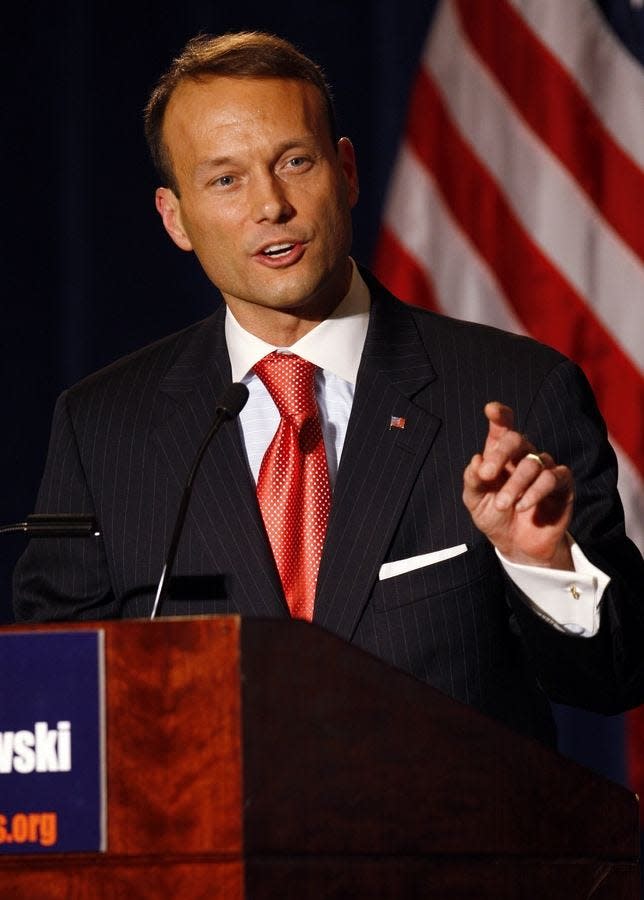Rand Paul is doing the right thing by asking for transparency in the NIH: Opinion
- Oops!Something went wrong.Please try again later.
Over the past two years, the National Institutes of Health has come under nearly unprecedented scrutiny as it has attempted to guide Americans through the pandemic with treatment and prevention guidelines and recommendations. Despite the public’s increased desire to understand how public health decisions are made, NIH has remained stubbornly opaque. Sen. Rand Paul is doing the right thing in attempting to change that, at least when it comes to understanding the financial stakes involved in much of NIH’s work.
The institute and its dozens of sub-agencies dole out roughly 32 billion worth of tax dollars annually in the form of research grants to pharmaceutical companies and the healthcare community, but they also receive a hidden stream of private royalty payments for their innovations.
The institute and roughly 1,800 of its scientists have received an estimated $350-$400 million in these payments, from entities like pharmaceutical companies, during the last decade. The public would have remained in the dark about this, but OpenTheBooks.com sued for the information after NIH ignored and denied lawful open records requests. Despite being forced to release the information, NIH is still redacting the amount of each individual payment, and which company paid it. Each royalty check is a potential conflict of interest left unexamined.
More: Charles Booker wears a noose in new Senate campaign ad blasting Rand Paul. Here's why:
Thankfully, Congress has taken note of the investigation and is finally using its oversight authority to demand some transparency. It began with President Biden’s 2023 federal budget request. NIH Acting Director Lawrence Tabak showed up in the House of Representatives to defend his portion of the spending, only to be questioned directly by Rep. John Moolenaar (R-Mich.). After extensive probing, Tabak finally admitted there appeared to be a conflict of interest, and Moolenaar suggested NIH share the royalties information in full, and as soon as possible.
Last week, Sen. Paul and his colleagues on the Senate Homeland Security and Government Affairs Committee joined that transparency push. Along with Sens. Ron Johnson (R-Wis.), Rick Scott (R-Fla.), Josh Hawley (R-Mo.) and Jim Lankford (Okla.), he fired off a letter to Tabak pushing for answers.
“[W]e believe that the American taxpayer deserves to know the degree to which government doctors and researchers have a financial interest in drugs and products they support, and whether any relationship exists between federal grants awarded by NIH and royalty payments received by NIH personnel,” the senators wrote.
It’s true, this revolving door of public grants likely affords NIH a lot of clout within the medical community, and it’s important to know if some of the same entities are paying royalties while they continue to accrue more financing for research and development.
Paul also brought up NIH leadership’s role in this secretive payment model, the bureaucrats who already pull down enormous salaries from the taxpayer. “Americans deserve greater transparency in how the hundreds of millions in royalty payments NIH receives are distributed, the degree to which NIH’s leadership, already among the highest-paid individuals in the federal bureaucracy – has benefited from this ‘hidden’ revenue stream,” he wrote to Tabak.
For Subscribers: Do GOP 'liberty' candidate wins mark state trend or is it just a Northern Kentucky thing?
Take for example the face everyone now knows from television, Dr. Anthony Fauci. He brought home $456,028 in salary last year– more than his boss, then-NIH director Francis Collins; more than Secretary of Health & Human Services Xavier Becerra; and even more than the president. He also received 26 royalty payments between 2010 and 2016, but we cannot confirm where they came from and for what innovation.
Another example is Dr. Robert Gallo, frequently one of the top royalties earners despite having left NIH in 1995. He collected 316 royalty payments over the same time period and now operates in the public health sector without the ethical guardrails that come with federal employment. These numbers are likely to keep growing as NIH continues to disclose more records, albeit heavily redacted, under the court’s order.
The work of scientists like Fauci, Gallo and others has increasingly informed our everyday behaviors. When it comes to personal health decisions and recommendations, it’s simply critical to understand all of the stakes involved.
While Congress too often fails to use the full force of its oversight abilities, Sen. Paul and his colleagues have taken an important step, and have set a deadline later this month for Tabak to finally give us some answers.
Lawmakers should keep up the pressure for transparency through public hearings, and revisit the laws and ethics rules that undergird these hidden payments. Thanks to Rep. Moolenaar, we know an obscure statute known as Bayh-Dole facilitates the current arrangement, and that it can be revisited to ensure it works for taxpayers and patients. And thanks to Sen. Paul, we may soon have a new trove of information we deserved all along.

Adam Andrzejewski is the CEO and founder of OpenTheBooks.com, the largest private database of U.S. public-sector expenditures.
This article originally appeared on Louisville Courier Journal: Rand Paul's questioning Dr. Fauci's NIH royalty payments is right

